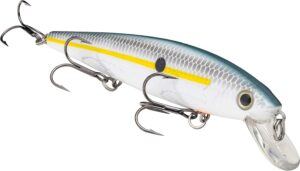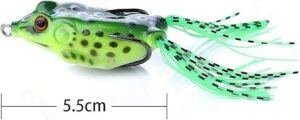How To Catch Big Springtime Bass Using Jerkbaits
In my opinion, one of the most electrifying times to target bass is during the spring season. As the waters warm, these fish shift into feeding mode, preparing for the energy-intensive spawning period. What’s remarkable about spring is how bass behavior can shift from day to day. One day they might be sluggish, the next, they’re aggressively chasing prey.
You’re going to find out about jerkbaits, a top-notch lure choice for this time of year. These lures mimic the erratic action of wounded baitfish, which is irresistible to predatory bass looking to fatten up before the spawn. They are phenomenal because you can control their motion with a twitch of your rod, making them dance in the water in a way that spells dinner for hungry bass.
That’s going to include looking into why jerkbaits are such an effective choice for springtime bass fishing. They excel in cooler waters where bass may be wary of committing to larger prey. Moreover, jerkbaits come in different depths and styles, allowing you to target bass whether they’re hanging out in shallow flats or suspended over deeper structures.
Choose something that resonates with you, and that could be the color, size, or action of the jerkbait. But, don’t worry too much about getting it perfect from the get-go. Bass can be unpredictable, and often, success boils down to experimenting with different lures under various conditions. With every cast, you learn more about what works and what doesn’t.
Now, let’s get a closer look at jerkbaits themselves—what makes a good jerkbait, how to pick one out, and why certain designs might be better for your local waters. Transitioning to the next section, you’ll become well-versed in choosing the right tools from your tackle box to land those impressive springtime bass.
Jerkbait Basics: Selecting the Right Tools for Trophy Bass
If you’re keen on landing those big, elusive springtime bass, let’s talk about choosing the right jerkbait. Not all jerkbaits are created equal, and the right one will make a significant difference in your fishing success. Jerkbaits are renowned for their ability to mimic a wounded baitfish a high-protein snack that’s hard for bass to resist in the energetic spring months.
One of my go to jerkbaits is the KVD Sexy Shad Jerkbait cause it has the perfect combination of roll, wiggle and flash. Click on the picture below to add the sexy shad to your tackle box.
So, what makes for an effective jerkbait? You’ll want to consider several factors, including buoyancy and depth range. Floating jerkbaits surface upon pause, making them ideal for shallow waters. If you’re targeting bass that are suspending deeper, a suspending jerkbait remains at a constant depth during the pause. For deep water or aggressive, active bass, sinking jerkbaits dive down, getting into their face and triggering a reactionary bite.
Color and size are also crucial when selecting your jerkbait. In clear water, choose jerkbaits with natural, subtle colors that resemble the local forage \’like shad or minnows. In murkier water, go for the brighter, more noticeable colors to stand out in the diminished visibility. Size them up right, too: larger jerkbaits can lure in trophy-sized bass looking for a substantial meal.
Let’s not forget about the gear. Pairing your jerkbait with the right rod, reel, and line is vital for the perfect execution of the technique. A medium-action rod with good sensitivity to detect those subtle bites is your best bet. Spool up with fluorocarbon line to achieve the perfect balance between invisibility, buoyancy, and responsiveness.
As you head into the next section, keep in mind that having the right jerkbait is just part of the equation. Knowing how to work it proficiently is going to greatly boost your chances of reeling in those big bass. So, pay attention to the techniques pros use to bring those jerkbaits to life in the water.
Mastering the Jerkbait Technique: Tips from the Pros
In my opinion, technique is everything when it comes to springtime bass fishing with jerkbaits. You’re going to find out how vital it is to finesse your retrieve to make that lure irresistible.
Now, the essential mechanics involve a ‘jerk and pause’ rhythm. That’s the strategy I like to leverage, and it works wonders. For spawning bass, shorten the pauses. Post-spawn? Lengthen them. It’s all about mimicking the erratic, vulnerable movements of prey.
Check out this video from the KING of jerkbait fishing Kevin Van Dam. In this video he explains tips and tricks on choosing the correct Jerkbaits based on conditions and clarity:
Choose something that resonates with you, but don’t worry too much about sticking to one pattern. Vary your speed and the intensity of your jerks. Consider a mix of aggressive snaps with gentler twitches. This isn’t just about creating movement; it’s also about creating the illusion of a struggling baitfish.
Meanwhile, keep an eye out for common mistakes. Overdoing the twitch or having too much slack line can turn the fish off. Always maintain a semi-slack line to ensure proper hook set. And remember, your first attempt at the perfect retrieve doesn’t need to be your last. You can always adjust your approach down the road.
Having these techniques dialed in will transition smoothly into finding the right spots to fish. You could have the perfect jerkbait and technique, but without being in the right location, you might as well be fishing in a desert. So, let’s talk about where to throw that perfect retrieve.
Locating Lunkers: Where to Find Big Bass in Spring
You might have the best jerkbait and technique in the world, but if you don’t know where the big bass are hiding, you’re likely to come up empty. Springtime bass behavior is largely influenced by the spawning cycle, which means you’ll find them in specific areas. We’re going to break down those key springtime bass locations to help you zero in on those trophy catches.
First up, let’s talk about warmer waters. As the water temperatures rise in the spring, bass move to shallow areas to spawn. Look for flats with a bit of cover, like submerged vegetation or wood. Spawning bass prefer firm bottoms, so areas with gravel or sand can be particularly productive. Pay close attention to transitional zones where shallow water meets deeper water – bass often use these ‘highways’ to move in and out of spawning areas.
I can’t emphasize enough the importance of stealth when you approach these spots. Big bass are wary creatures, especially in the shallows. Keep a low profile and use your electronics sparingly to avoid spooking your target. Another hot tip is to keep an eye out for bird activity. Birds diving or flocking can often indicate baitfish, which in turn indicates predator fish beneath.
Now, if you’re after post-spawn bass, the game changes a bit. Post-spawn bass are often exhausted and hungry, and they’ll retreat to areas where they can easily ambush prey. This includes points, drop-offs, and deeper structures. Your sonar and GPS technology are invaluable here, helping you spot these areas and keep track of where you’ve had bites and catches. Logging your catches can reveal patterns over time, showing you the most fruitful areas under specific conditions.
Caring for your catch is just as important as landing it. This brings us to conservation and safety — topics that deserve our utmost attention. In the next section, I’m going to share some essential tips on how to handle bass for catch and release, and stay safe while you’re enjoying the great outdoors this spring.
Conservation and Safety: A Responsible Angler’s Guide
If you want to enjoy bass fishing for years to come, it’s vital to adopt a conservation mindset. Practicing catch and release effectively ensures the future of the sport. When you catch that prized bass using a jerkbait, handle it with care. Use wet hands to prevent removing the protective slime coat on the fish, and avoid keeping the fish out of water for too long.
Safety should never be an afterthought when you’re out on the water. Always check weather forecasts before heading out. Sudden spring storms can arise, so be prepared and wear a life vest. Don’t forget to pack a first aid kit. It’s better to have it and not need it, than the other way around.
Lastly, respecting local regulations and ethical considerations is a cornerstone of responsible angling. Familiarize yourself with catch limits, size regulations, and any seasonal restrictions. Conservation isn’t just about you; it’s about ensuring that everyone can enjoy the thrill of catching big springtime bass for generations to come.
So there you have it. With the right approach and a respect for the water, conservation, and safety, you’re all set to go after those big springtime bass with jerkbaits. Remember, the true trophy isn’t just the fish, but the memories and experiences you create along the way. Tight lines!



